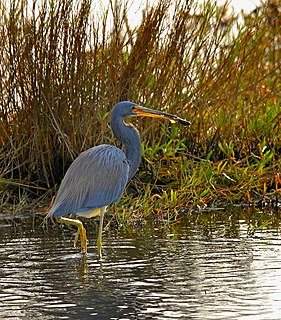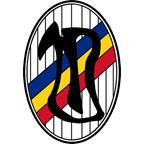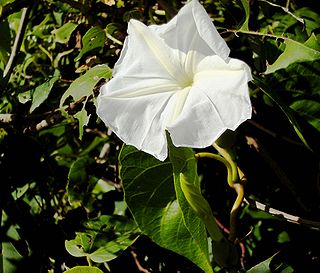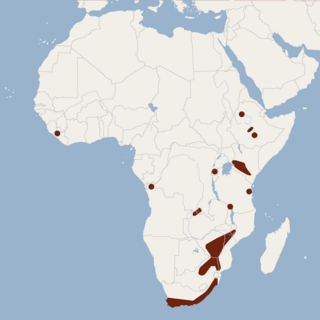Related Research Articles

The national flag of Romania is a tricolor with vertical stripes, beginning from the flagpole: blue, yellow and red. It has a width-length ratio of 2:3.
Tricolor or tricolour, or tricolored, tricoloured, may refer to:

Wilson's phalarope is a small wader. This bird, the largest of the phalaropes, breeds in the prairies of North America in western Canada and the western United States. It is migratory, wintering in inland salt lakes near the Andes in Argentina. They are passage migrants through Central America around March/April and again during September/October. The species is a rare vagrant to western Europe.

The tricolored heron, formerly known as the Louisiana heron, is a small species of heron native to coastal parts of the Americas; in the Atlantic region, it ranges from the northeastern United States, south along the coast, through the Gulf of Mexico and the Caribbean, to northern South America as far south as Brazil. In the Pacific region, it ranges from Peru to California, but it is only a nonbreeding visitor to the far north.

Wild pansy, also known as Johnny Jump up, heartsease, heart's ease, heart's delight, tickle-my-fancy, Jack-jump-up-and-kiss-me, come-and-cuddle-me, three faces in a hood, love-in-idleness, or pink of my john, is a common European wild flower, growing as an annual or short-lived perennial.

The tricolored bat is a species of microbat native to eastern North America. Formerly known as the eastern pipistrelle, based on the errant belief that it was closely related to European Pipistrellus species, the closest known relative of the tricolored bat is now recognized as the canyon bat. Its common name "tricolored bat" derives from the coloration of the hairs on its back, which have three distinct color bands. It is the smallest bat species in the eastern and midwestern US, with individuals weighing only 4.6–7.9 g (0.16–0.28 oz). This species mates in the fall before hibernation, though due to sperm storage, females do not become pregnant until the spring. Young are born helpless, though rapidly develop, flying and foraging for themselves by four weeks old. It has a relatively long lifespan, and can live nearly fifteen years.

The Arctic shrew, also known as the blackback shrew or saddlebacked shrew, is a medium-sized shrew found in Canada and the northern United States. Separate species status has been proposed for the maritime shrew which is found in New Brunswick and Nova Scotia and had been considered to be a subspecies of the Arctic shrew. The tundra shrew was formerly considered to be a subspecies of the Arctic shrew.

Unirea Tricolor Bucureşti was a Romanian football club from Bucharest, south-east Romania, founded in 1926 when two clubs, Unirea Bucureşti and Tricolor Bucureşti merged.
Simaethistoidea is an obscure superfamily of pyralid-like moths with two genera, whose biology and relationships among the Ditrysia is currently unknown, namely the Australian Metaprotus and the China and North Indian Simaethistis.

Ipomoea violacea is a perennial species of Ipomoea that occurs throughout the world with the exception of the European continent. It is most commonly called beach moonflower or sea moonflower as the flowers open at night.

The tricolored big-eared bat is a bat species from South and Central America.

In the mathematical field of knot theory, the tricolorability of a knot is the ability of a knot to be colored with three colors subject to certain rules. Tricolorability is an isotopy invariant, and hence can be used to distinguish between two different (non-isotopic) knots. In particular, since the unknot is not tricolorable, any tricolorable knot is necessarily nontrivial.
The hybrid elm cultivar Ulmus × hollandica 'Tricolor' was first listed as U. suberosa tricolor by C. de Vos in 1867.

The Cape hairy bat, also known as little brown bat, Temminck's mouse-eared bat, Cape myotis, tricoloured mouse-eared bat, Cape hairy myotis, Temminck's hairy bat and three-coloured bat is a species of vesper bat that is found in Sub-Saharan Africa.

Tricolor TV is the Russia's largest direct-to-home provider based in Saint-Petersburg and has broadcast two hundred TV channels in the European part of Russia and Siberia since 2005. As of October 2014, Tricolor TV provided satellite services to over fifteen million subscribers.

Convolvulus tricolor is a species of flowering plant in the family Convolvulaceae, native to Mediterranean Europe. Common names include dwarf morning-glory and tricolour convolvulus.
Ecsenius tricolor, known commonly as the Derawan combtooth-blenny in Indonesia, is a species of combtooth blenny in the genus Ecsenius. It is found in the western central Pacific ocean, around the Philippines and Borneo. It can reach a maximum length of 6 centimetres. Blennies in this species feed primarily off of plants, including benthic algae and weeds.
Simaethistis leechi is a moth in the family Simaethistidae. It was described by South in 1901. It is known from China.

The cockade of Italy is the national ornament of Italy, obtained by folding a green, white and red ribbon into a plissé using the technique called "plissage" (pleating). It is one of the national symbols of Italy and is composed of the three colors of the Italian flag with the green in the center, the white immediately outside and the red on the edge: this convention on the position of colors derives from the cockades used in Bologna in 1794 during an attempt of revolt, which had this chromatic composition. The cockade with the red and green inverted position is instead that of Iran.
References
- ↑ Beccaloni, G.; Scoble, M.; Kitching, I.; Simonsen, T.; Robinson, G.; Pitkin, B.; Hine, A.; Lyal, C., eds. (2003). "Simaethistis tricolor". The Global Lepidoptera Names Index . Natural History Museum . Retrieved May 14, 2018.
| This moth-related article is a stub. You can help Wikipedia by expanding it. |